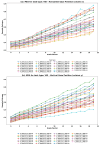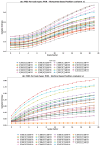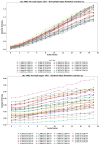Exploring Gaze Dynamics in Virtual Reality through Multiscale Entropy Analysis
- PMID: 38544043
- PMCID: PMC10975790
- DOI: 10.3390/s24061781
Exploring Gaze Dynamics in Virtual Reality through Multiscale Entropy Analysis
Abstract
This study employs Multiscale Entropy (MSE) to analyze 5020 binocular eye movement recordings from 407 college-aged participants, as part of the GazeBaseVR dataset, across various virtual reality (VR) tasks to understand the complexity of user interactions. By evaluating the vertical and horizontal components of eye movements across tasks such as vergence, smooth pursuit, video viewing, reading, and random saccade, collected at 250 Hz using an ET-enabled VR headset, this research provides insights into the predictability and complexity of gaze patterns. Participants were recorded up to six times over a 26-month period, offering a longitudinal perspective on eye movement behavior in VR. MSE's application in this context aims to offer a deeper understanding of user behavior in VR, highlighting potential avenues for interface optimization and user experience enhancement. The results suggest that MSE can be a valuable tool in creating more intuitive and immersive VR environments by adapting to users' gaze behaviors. This paper discusses the implications of these findings for the future of VR technology development, emphasizing the need for intuitive design and the potential for MSE to contribute to more personalized and comfortable VR experiences.
Keywords: eye movements; human sensing; multiscale entropy; time series analysis; user experience; virtual reality.
Conflict of interest statement
The authors declare no conflicts of interest.
Figures







Similar articles
-
GazeBaseVR, a large-scale, longitudinal, binocular eye-tracking dataset collected in virtual reality.Sci Data. 2023 Mar 30;10(1):177. doi: 10.1038/s41597-023-02075-5. Sci Data. 2023. PMID: 36997558 Free PMC article.
-
EHTask: Recognizing User Tasks From Eye and Head Movements in Immersive Virtual Reality.IEEE Trans Vis Comput Graph. 2023 Apr;29(4):1992-2004. doi: 10.1109/TVCG.2021.3138902. Epub 2023 Feb 28. IEEE Trans Vis Comput Graph. 2023. PMID: 34962869
-
BioMove: Biometric User Identification from Human Kinesiological Movements for Virtual Reality Systems.Sensors (Basel). 2020 May 22;20(10):2944. doi: 10.3390/s20102944. Sensors (Basel). 2020. PMID: 32456023 Free PMC article.
-
Survey of Movement Reproduction in Immersive Virtual Rehabilitation.IEEE Trans Vis Comput Graph. 2023 Apr;29(4):2184-2202. doi: 10.1109/TVCG.2022.3142198. Epub 2023 Feb 28. IEEE Trans Vis Comput Graph. 2023. PMID: 35015645 Review.
-
A review on ergonomics evaluations of virtual reality.Work. 2023;74(3):831-841. doi: 10.3233/WOR-205232. Work. 2023. PMID: 36442175 Review.
Cited by
-
Artificial intelligence in breast cancer survival prediction: a comprehensive systematic review and meta-analysis.Front Oncol. 2025 Jan 7;14:1420328. doi: 10.3389/fonc.2024.1420328. eCollection 2024. Front Oncol. 2025. PMID: 39839787 Free PMC article.
References
-
- Billinghurst M., Clark A., Lee G. A survey of augmented reality. Found. Trends Hum. Comput. Interact. 2015;8:73–272. doi: 10.1561/1100000049. - DOI
-
- Mihelj M., Novak D., Beguš S. Virtual Reality Technology and Applications. Springer; Dordrecht, The Netherlands: 2014.
-
- Kaewrat C., Boonbrahm P., Sahoh B. The Design and Development of a Foot-Detection Approach Based on Seven-Foot Dimensions: A Case Study of a Virtual Try-On Shoe System Using Augmented Reality Techniques. Informatics. 2023;10:48. doi: 10.3390/informatics10020048. - DOI
MeSH terms
LinkOut - more resources
Full Text Sources

